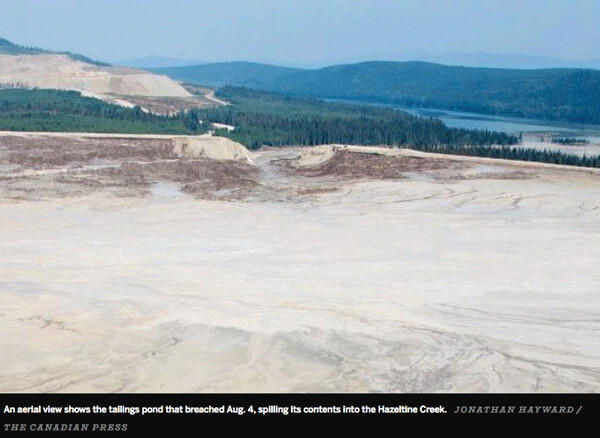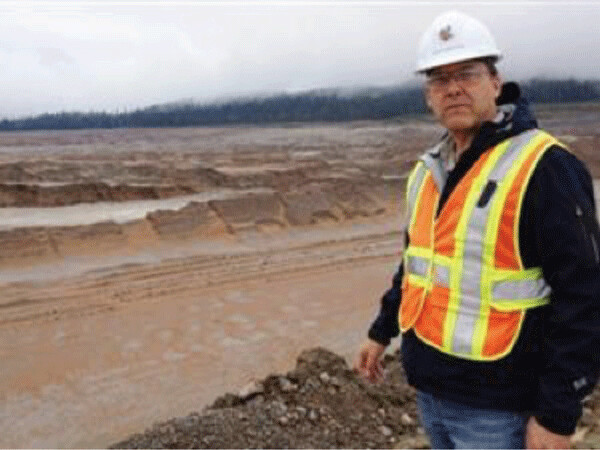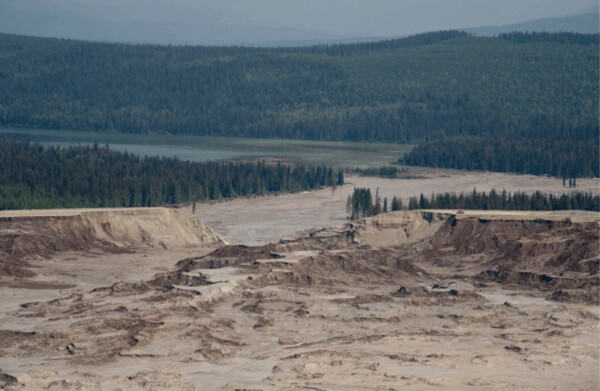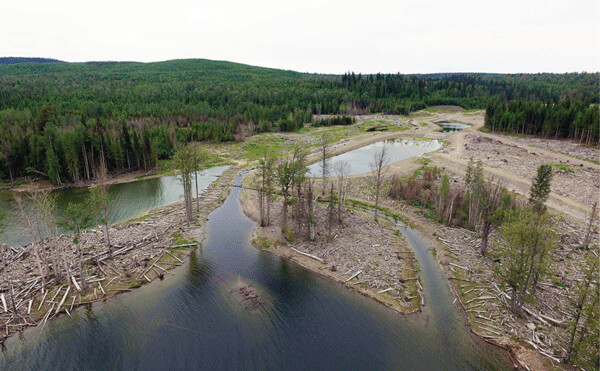News & Articles
Browse all content by date.
Before reading the timeline of the aftermath of the Mt Polley disaster, please go to the site further below where there are a number of photos of the consequences of the breach of the lagoon dam (which was 130 feet tall) when a portion of it dissolved and failed.
The remains of the state-of-the-art tailings ”pond” at Mount Polley still holds 80% of the original toxic waste from the massive, adjacent open pit copper mine. “Only” 24 million cubic meters of the sludge (=20%) was discharged after the dam failed.
The enormous flow of the toxic mixture of sludge and liquid permanently eroded the downstream, originally “tiny”, Hazeltine Creek (average width 6 feet wide) that emptied into Quesnel Lake. The sludge permanently contaminated the creek bed and wiped out adjacent forest land and, of course, filled the bottom of the once pristine Quesnel Lake with highly poisonous and carcinogenic heavy metals and other toxic materials.
Quesnel Lake is actually a reservoir that empties into the Fraser River near the tiny town of Likely, British Columbia (population 350).
The 600 mile-long Fraser River eventually empties into the Pacific Ocean at Vancouver, British Columbia. Quesnel Lake can never be the same after the solids settled to the bottom and the liquid poisons dispersed into the lake. Quesnel received 99% of the 24,000,000 cubic meters of toxic tailings discharge, but, of course, the downstream Fraser River was also heavily contaminated.
View the photos at this site, and then empathize with the water protectors and concerned Minnesotans and Lake Superior lovers who live and recreate and drink the water from (or fish in, or harvest wild rice from) the St Louis River watershed and Lake Superior.
Water protectors are logically fearful of what might happen if and when PolyMet’s 250 foot-high earthen dam dissolves sometime in the future, as has happened many times before when mine waste in stored for eternity behind earthen dams.
Logic and the concern for others demands vigorous non-violent resistance to the granting of permission to mine from the Minnesota DNR, EPA and US Forest Service to Switzerland’s Glencore and Chile’s Antofagasta, both of which easily qualify for a diagnosis of sociopathic personality disorder and thus can’t be trusted to tell the truth.
The risks of a Mount Polley-type disaster are way too high to cavalierly grant permission to non-human mining companies to store massive volumes of liquified and highly toxic mine waste upstream from vulnerable children and other living things.
Read this and weep – and then go to the streets to make sure that such state of the art, highly poisonous copper sulfide mines are never built in water-rich areas such as northern Minnesota.
https://www.google.com/search?q=mount+polley+mine+layoffs&sa=N&rlz=1C2CHZL_enUS756US756&tbm=isch&tbo=u&source=univ&ved=0ahUKEwiywc6Pop_ZAhUKS2MKHV-rAcg4FBDsCQhK&biw=1163&bih=492
I begin the timeline with a paragraph from the final draft of a report assessing the Mount Polley disaster after it had been studied for several years. It was written by various “experts”, some of whom were connected with the mining industry. Note the un-emotional language that tends to distract the reader from fully appreciating the enormity of the disaster, which has justifiably been characterized as the worst environmental disaster in the history of Canada.
“Early in the morning on August 4, 2014, a breach occurred at the Perimeter Embankment of the Tailings Storage Facility (TSF) due to the failure of an underlying glacial lacustrine layer that was not appropriately characterized or accounted for in engineering designs (Morgenstern et al. 2015). The TSF embankment breach released an estimated 10.6 million cubic metres (Mm3 ) of supernatant, 13.8 Mm3 of tailings slurry (7.3 Mm3 of tailings solids and 6.5 Mm3 of interstitial water), and 0.6 Mm3 of embankment construction materials to the receiving environment. This material flowed into the adjacent Polley Lake, and then down the ~9 km Hazeltine Creek channel to Quesnel Lake, causing ~236 hectares (ha) of varying degrees of erosion and deposition in the creek valley, as well as deposition in Polley and Quesnel Lakes (Miller et al. 2015).”
August 14, 2014 42 workers laid off from the Mount Polley Mine following tailings pond breach
By Amy Judd Online News Producer Global News
https://globalnews.ca/news/1509134/42-workers-laid-off-from-the-mount-polley-mine-following-tailings-pond-breach/
B.C.’s privacy commissioner will investigate whether the provincial government failed in its duty to warn the public about conditions at the Mount Polley tailings pond. Meantime, dozens of workers at the mine received layoff notices. Jas Johal has the latest. VANCOUVER – No money is currently being generated at the Mount Polley Mine near Likely, B.C. This is a cleanup operation now with the impact of last week’s spill clearly being felt with 42 workers being laid off on Thursday. “At first everyone’s in shock, “said Paul French, United Steelworkers Local 1425 president. “Then comes the fear of them losing their job. Now we’re in the reality stage of ‘OK now what do I do?'” With the cleanup effort continuing, more than 300 employees still don’t know their future. Many make over $100,000 a year mining, with another 1,000 other suppliers who rely on the mine. The permanent closure of Mount Polley would be devastating for Likely. “We’re all hoping for the best that we can get the mine back up and running,” said French. “Get the cleanup done and keep our guys working.” Beyond layoffs, the problems for Imperial Metals are just beginning. The cleanup costs are expected to be astronomical with one analyst at BMO Nesbitt Burns estimating it will cost 200-million dollars, and that’s before legal damages, which could double the amount. The company says it has 15 -million dollars in business interruption insurance coverage. Even though the government insists the province has a Polluter Pays Principle, there’s no guarantee Imperial Metals can come up with the cash. Imperial Metals officials say getting Mount Polley up and running to generate cash flow may be the way to pay for the cleanup. Without it analysts say the company may have to sell assets to absorb the financial impact. The repercussions of this spill are environmental, economic, and political.
November 15, 2014
Imperial Metals pegs Mount Polley cleanup cost at $67 million
http://www.vancouversun.com/technology/Imperial+Metals+pegs+Mount+Polley+cleanup+cost+million/10389778/story.html
“spring run-off will bring more tailings debris into Quesnel Lake”

GORDON HOEKSTRA, VANCOUVER
Contents from the Mount Polley tailings pond are pictured going down previously tiny Hazeltine Creek into Quesnel Lake near the town of Likely on Aug., 4, 2014.


JONATHAN HAYWARD / THE CANADIAN PRESS Mount Polley expert panel calls for public submissions into dam collapse
Mount Polley mine lays off 36 workers
Photo of the Mount Polley dam breach from a perspective above the tailings pond. The dam measures 130 feet from its base and most of the dam is still containing 80% of the contents. Also note that the slope of the dam could have had nothing to do with its failure.
Imperial Metals has estimated it will cost $67.4 million for cleanup and rehabilitation of the Mount Polley gold and copper mine tailings dam spill. The collapse of the tailings dam on Aug. 4 released millions of cubic metres of water and tailings containing potentially-toxic metals into the Quesnel Lake watershed, important habitat for Fraser River sockeye salmon. The company released the cost figure — the first detailed estimate — with its financial results for the three months ending in September, a loss of $49.2 million attributed largely to the loss of profits from Mount Polley. Imperial’s cleanup cost estimate is lower than those of some industry analysts. Raymond James analyst Adam Low has estimated a cleanup cost of $100-million. And BMO analyst Aleksandra Bukacheva noted the total scope of remediation costs is undetermined “even as the company reviews options for the resumption of operations.” (Those options include repairing the tailings facility and temporarily using one of the pits to store tailings). Bukacheva earlier pegged the cleanup cost to the company at $200 million. Imperial Metals had spent $20.3 million of the $67.4 million by the end of September, and expects to recover at least $25 million through insurance coverage. The remainder of the $67.4 million is expected to be spent during the next nine months although there will be some future costs for sampling to test the results of the rehabilitation, the company said. Imperial Metals CEO Bryan Kynoch said the stabilization and recovery phase of the tailings dam collapse is now complete, and the company has started work on rehabilitating the lower third of Hazeltine Creek. The rush of tailings and water scoured and widened the nine-kilometre creek, home to spawning trout and Coho salmon. “Our focus is try to do this as quickly as possible and try to be ready for next spring’s run-off,” Kynoch said Monday during a conference call to discuss the company’s financial results. There is concern among residents in the nearby community of Likely, First Nations and environmental groups that the spring run-off will bring more tailings debris into Quesnel Lake. Rehabilitation of the creek will include stabilizing banks and planting new vegetation, explained Kynoch. The company does not expect to have to remove tailings from the creek because most of it ended up in Quesnel Lake along with material from the creek, he said. In a written statement, B.C. environment officials said Monday information about the cleanup plan, which must be approved by the province, will be released shortly. Environment officials said Quesnel Lake will be part of the cleanup plan. ghoekstra@vancouversun.com
February 27, 2015 B.C.’s Mount Polley mine confirms layoffs on the table if it can’t reopen soon
http://www.financialpost.com/m/search/mount+polley+mine+confirms+layoffs+table+reopen+soon/10849352/story.html
Rob Shaw, Vancouver Sun

Steve Robertson, Imperial Metals, vice-president of corporate affairs, at the edge of the Mount Polley gold and copper mine’s tailing pond. Robertson said Friday that the mine may have to start layoffs after April 1. Part of the tailings dam collapsed Aug. 4, releasing more than 24 million cubic metres of water and tailings into Hazeltine Creek, Polley Lake and Quesnel Lake. - Gordon Hoekstra
VICTORIA — Workers at the Mount Polley mine could face layoffs starting April 1, the mine owners confirm. Imperials Metals, which operates the gold and copper mine near Williams Lake, said it will finish repairs to the breached section of its tailings dam around April 1 and, without a permit from government to partly restart the mine, won’t be able to retain all of its approximately 300 employees. “Once the reconstruction of the breach area is completed, we will be in a position of having to consider layoffs,” company vice-president Steve Robertson wrote in an email. “However, if the short term approval for operations is in place at that time, the crews could bridge directly over to operations work and continue on.” Mines Minister Bill Bennett has said the company’s timeline is unrealistic and the government is “not going to be squeezed into making a decision prematurely” on allowing the mill to reopen. Bennett said Imperial Metals has not provided enough information on how it will manage tailings and water flow in the long term. The mine has been shut since Aug. 4, the day its earthen and rock dam failed and released dirty water into nearby rivers and lakes. Since then, the company has retained most of its workforce to help repair the environmental damage caused by the breach. Robertson said Imperial Metals will “make every reasonable effort to keep our crews employed, but there may be a point where there is no work available. “This is a stressful time for our employees, their families and the surrounding communities, to see that their future is so uncertain. I can tell you that (Mount Polley) will work diligently to fulfil all of the requirements that are asked of us for permitting, but to a certain degree the timing on these matters is out of our control.” A panel of expert engineers has said a design flaw in the dam was the main cause of the collapse.
May 6, 2015 Union Says 120 Layoffs At B.C.'s Mount Polley Mine Leaves 'Skeleton Crew'
Darpan News Desk The Canadian Press
https://www.darpanmagazine.com/news/national/union-says-120-layoffs-at-bcs-mount-polley-mine-leaves-skeleton-crew/

A photo of the highly poisonous tailings remaining behind at the Mt Polley “Dam Breach” ·
LIKELY, B.C. — The union representing workers at a British Columbia mine hit by a tailings pond breach says continued layoffs have left a skeleton crew as the facility prepares for a potential restart. Another 120 layoff notices have been handed out to employees handling cleanup, repairs and remediation at the Mount Polley mine operated by Imperial Metals Corp. (TSE-Ill). The tailings dam at the gold and copper mine in central B.C. collapsed last summer, spilling millions of cubic metres of waste into area waterways. Fifty people were laid off in February, and another 36 lost their jobs last November. United Steelworkers Local 1-425 president Paul French says there is simply no work, but he expects operations to restart by mid-July if Imperial Metals is granted a permit to reopen. Company spokesman Steve Robertson said last week that more than half of Mount Polley's 370 employees would be back at work if operations resume. (250 News, The Canadian Press)
May 6, 2015 More Mount Polley layoffs
http://cfnrfm.ca/more-mount-polley-layoffs/
Posted by: Gene Law
The union representing workers at a British Columbia mine hit by a tailings pond breach says continued layoffs have left a skeleton crew as the facility prepares for a potential restart. Another 120 layoff notices have been handed out to employees handling cleanup, repairs and remediation at the Mount Polley mine operated by Imperial Metals. The tailings dam at the gold and copper mine in central B.C. collapsed last summer, spilling millions of cubic metres of waste into area waterways. Fifty people were laid off in February, and another 36 lost their jobs last November. United Steelworkers Local 1-425 president Paul French says there is simply no work, but he expects operations to restart by mid-July if Imperial Metals is granted a permit to reopen. Company spokesman Steve Robertson said last week that more than half of Mount Polley’s 370 employees would be back at work if operations resume.
August 4, 2016 BC
Mount Polley mine disaster hits 2-year mark, fallout still causes divisions
”We don't want the mine to go away. We just want things done right, a local official says” "All this year, we've had a green hue colour in the lake, a colour that's never been there before.”
By Dirk Meissner, The Canadian Press
Lisa Kraus says it's been a difficult two years in the tiny central British Columbia community of Likely, where the collapse of a massive tailings dam at the Mount Polley mine opened wounds that have yet to heal. Twenty-four million cubic metres of mine waste and water gushed into nearby lakes and rivers on Aug. 4, 2014. An independent, government-ordered panel of experts concluded the cause was an inadequately designed dam at the Imperial Metals open pit copper and gold mine that didn't account for drainage and erosion failures beneath the pond. One of the panel's geotechnical engineers described the location and design of the pond as loading a gun and pulling the trigger. "We were woken up in the middle of the night," said Kraus, who lives on riverfront property just downstream from the mine site. "We had people camped down in our lower lot and we were told to wake them up ... because we were uncertain how much or what was going to come down from the lake into the river."
'We want it back the way it used to be'
There were no casualties, but the collapse dumped millions of cubic metres of mine waste into Quesnel Lake and clogged salmon-bearing streams and rivers with waste and trees. Kraus, who serves as Likely's chamber of commerce vice president and community co-ordinator, said despite government reports that water quality in Quesnel Lake meets provincial drinking quality guidelines, many residents are still concerned. "All this year, we've had a green hue colour in the lake," she said. "A colour that's never been there before. It's a concern. We want it back the way it used to be."

An aerial view shows the damage caused by a tailings pond breach near the town of Likely the day after the spill. 24.000.000 cubic meters of poisonous tailings, the entirety of Hazeltine Creek and the thousands of trees that used to border it have been washed into Lake Quesnel below. (Jonathan Hayward/Canadian Press)
Kraus said some people now refuse to drink the water. "People here still fight with each other about it," she said. "They're frustrated because things aren't what they used to be. We don't want the mine to go away. We just want things done right." Mines Minister Bill Bennett said the disaster prompted independent reviews and resulted in the province implementing world-leading regulatory standards for the mining industry. But Bennett conceded it will take time for British Columbians to become confident and comfortable with the protections aimed at preventing similar disasters. "It was a miracle nobody got hurt," he said. "There could have been people camped down at the mouth of Hazeltine Creek when that accident happened. There could have been workers on the dam. There wasn't. We just were really fortunate we've learned an important lesson without anybody being injured or worse."
Changes made, but what about public confidence?
B.C. revised its mining code to include global-leading safety and design standards for mine tailings storage facilities, Bennett said. It also strengthened the government's regulatory oversight of the mining industry and increased compliance and enforcement tools. But the Sierra Club of B.C. and mining expert Dave Chambers said the province is not doing enough to hold mining companies to account and prevent future disasters. The Sierra Club released a report by Chambers that concludes the government could do more to ensure safety at tailings storage facilities.

Imperial Metals president Brian Kynoch addressed local residents in an emotionally-charged meeting at the community hall in Likely, B.C., shortly after the disaster. (Kirk Williams/CBC)
"Unfortunately, we continue to see overly optimistic predictions about water quality impacts and tailings dam design and operation that push the limits of credibility, largely because of financial pressure on both mine operators and consultants," said the report. Sierra Club spokesman Bob Peart said British Columbians are not convinced the government is ensuring safety and protection of the environment are put ahead of mining company interests. "Safety, stability should be paramount — not profit for the company or revenue for the government," he said. Opposition New Democrat mines critic Doug Donaldson said much time has passed and yet nobody has been held accountable for the Mount Polley breach. "That does little to bolster public confidence in this not happening again," he said. Aug. 3, 2017
British Columbia won't charge Imperial Metals for Mount Polley dam breach
By Emma Crawford Hampel - Business in Vancouver

Aerial view of what used to be the mouth of little Hazeltine Creek, wiped out by the Mount Polley tailings-dam breach, August 2014 (BIV)
No charges will be laid under British Columbia’s environmental laws in relation to Imperial Metals Corporation’s (TSX:III) Mount Polley tailings dam breach of August 4, 2014.
This Friday, August 4, marks the end of the three-year statute of limitations for charges relating to the disaster on a provincial level, and these charges are not possible without a completed provincial-federal investigation. Chris Doyle, the deputy chief of the British Columbia Conservation Officer Service, confirmed to Business in Vancouver that such an investigation has not been completed and will not be completed by Friday, but "the investigation continues," as Fisheries and Oceans Canada, the Conservation Officer Service and Environment and Climate Change Canada are working together to further examine facts surrounding the disaster. George Heyman, B.C.’s minister of environment and climate change strategy, reiterated in a statement a “complete investigation” remains an objective, and federal charges under the Fisheries Act remain on the cards. “All of the information gathered during the course of this investigation will be considered by the Public Prosecution Service of Canada should charges be recommended,” he said. “Potential charges under the federal fisheries act remain very much in play and, in fact, potential penalties are more significant.”
January 3, 2018

Mount Polley Mining Corporation plans to lay off about 78 employees by the end of 2018 to pay for work it still has to complete because of the Aug. 2014 tailings breach. Photo submitted
Staged layoffs at Mount Polley in 2018 will impact 78 jobs Mount Polley Mine is beginning staged lay-offs to pay for projects it must complete because of the 2014 breach.
MONICA LAMB-YORSKI Imperial Metals is beginning staged lay offs at its Mount Polley Mine near Williams Lake that will impact about 78 full-time positions by the end of 2018. The move comes in order to pay for projects the company has to complete because of the 2014 tailings breach, Mount Polley Mining Corporation general manager Dale Reimer told the Tribune Wednesday. “We are trying to get cash positive for 2018 because we have some big projects we have to do to keep the mine going,” Reimer said. Those projects include removing the tailings that were put into the Springer Pit after the mine breach and more restoration work to Hazeltine Creek because of the damage caused by the breach. “We also have more work to do to lift our tailings dam a bit,” Reimer said. “We have to be cash positive to do those projects for the long-term mine liability.” “Approximately 16 people will be laid off in the first quarter,” Reimer confirmed. In the second quarter the company will lay off another 26 people, in the third quarter an additional 16 and in the fourth quarter approximately 10 more, he confirmed. It is also expected that an additional 39 people who were working under a temporary contract that expires in January 2018 will no longer be working at the mine after next week, Reimer said. For the most the part, the restoration work is done by the company, except for dredging of the Springer Pit which has be to be done by experts, Reimer explained. “We don’t have the equipment or the knowledge. It’s very specific work.” In the last six months of 2018, the mine will be using its stock piles and won’t be doing any additional mining, Reimer noted. Presently there are 337 people working at the mine. If the mine can get all the work done that is required it is hoped the number of employees will be back up to that level in the future, Reimer said. United Steelworkers Union Local 2017 past president Paul French declined comment on the lay-offs because the union is in contract talks with the company.
Nov 17- 2017
Mount Polley Mining Company shares remediation plans
Remediation work and planning continues in response to the 2014 tailings impoundment breach
By MONICA LAMB-YORSKI
https://www.wltribune.com/news/mount-polley-shares-remediation-plans/
“In the last three weeks we’ve seen more of that green slime and greenish water coming down the lake, which would be indicative of a recent release of suspended solids…The turbidity is there and there is copper in the bottom of the lake that is coming up.” – Quesnel Lake resident Doug Watt
Mount Polley Mine has removed 350,000 tonnes of tailings in a 13.9-hectare area and restored 1.25 kilometers of fish habitat as part of its ongoing remediation of areas impacted by the 2014 tailings impoundment breach, environmental supervisor Colleen Hughes said. Hughes was speaking at a community meeting hosted by the mine at the legion in Williams Lake Thursday that attracted 16 people. “We have also installed 6.4 kilometres of the pipeline [to Quesnel Lake] and Hazeltine Creek is no longer reporting to the diffusers in Quesnel Lake,” Hughes said. Lee Nikl, senior environmental scientist with Golder Associates, outlined remediation monitoring that has been completed so far and considerations Imperial Metals is taking as the work continues. A human health risk assessment completed and submitted by Golder has been accepted by the Ministry of Environment and an ecological risk assessment is being finalized, Nikl said. “We were asked immediately after the breach what is being done to stop ongoing releases from the breach area, how much was released and what are the effects of the release on health and on the environment and what is Mount Polley doing to fix the environmental effects?” Nikl added.
As a result, the mine identified nine remediation areas that included
1) the plug at Polley Lake,
2) Polley Lake,
3) the tailings storage facility,
4) upper Hazeltine Creek,
5) Hazeltine Canyon,
6) Lower Hazeltine Creek,
7) Edney Creek Mouth and
8) Quesnel Lake.
“For each of those areas we’ve come up with a table to see what are the problems, what do we know is wrong, what is it that we already know that will inform the decisions that we make, and what do we need to know to do in the short-term and what do we think we will do in the long-term,” Nikl said. “There is always uncertainty in any sort of scientific endeavour, so we needed to determine what sort of contingency there might be to deal with that uncertainty and what kind of monitoring would be done.” Quesnel Lake resident Doug Watt said he knows the pristine quality of the lake prior to the breach has not been restored. “In the last three weeks we’ve seen more of that green slime and greenish water coming down the lake, which would be indicative of a recent release of suspended solids,” Watt said. Responding Chief Scientific officer Lyn Anglin said a research group from the University of Northern British Columbia has sent lake sediment core samples to a lab in the United Kingdom for further research. “They will be looking at what the sheer force needs to be to re-suspend sediments off the bottom of Quesnel Lake,” Anglin said. “All of the creeks that run into the lake do contribute sediment so there are a lot of sources.” Anglin said it is difficult to make comparisons because the data prior to the breach is very limited, but if there are things people think the monitoring programs are missing, Mount Polley is open to suggestions. Watt said people on the lake know the slime, which they call “rock snot,” was not there before. “The turbidity is there and there is copper in the bottom of the lake that is coming up,” Watt added. He also criticized the company for adhering to water quality standards that are “totally artificial to Quesnel Lake.” “You are not looking to return the lake to what it was before and you are using the lake as a depository for the effluent,” Watt said. “That still bothers us.” Nikl replied that water quality guidelines are only one of the measures used for monitoring. “We look at many other measures such as invertebrate, toxicity testing in solid phase and water phase,” he said, noting ongoing geochemistry studies are looking at whether the copper is being released from the bottom of the lake. Hughes encouraged people at the meeting to read the technical and monitoring reports that area available on the Imperial Metals website.
Dr Kohls is a retired physician from Duluth, MN, USA. He writes a weekly column for the Duluth Reader, the area’s alternative newsweekly magazine. His columns deal with the dangers of American imperialism, fascism, corporatism (including Big Mining), militarism, racism, malnutrition, Big Pharma’s psychiatric drugging and over-vaccination regimens, and other movements that threaten the environment, prosperity, democracy, civility and the health and longevity of the planet and the populace. Many of his columns are archived at http://www.globalresearch.ca/author/gary-g-kohls; http://duluthreader.com/search?search_term=Duty+to+Warn&p=2; or at https://www.transcend.org/tms/search/?q=gary+kohls+articles
| Tweet |


